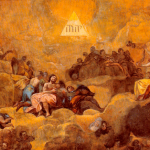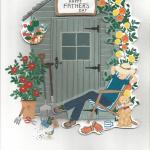My pal, Deacon Steven Greydanus, writes an encomium to the sheer greatness of these cartoons that says everything I could ever say and more. Here’s a taste, but read the whole thing:
It’s hard to believe that many American children had their first experience of Sylvester and Tweety Bird in a 2011 computer-animated short, “I Tawt I Taw a Putty Tat,” accompanying Happy Feet Two. Hard to believe, first, that Sylvester and Tweety made it back to the big screen — and, second, that these iconic animated characters that defined Saturday morning for decades and were beloved big-screen icons before that have become pretty much strangers to many of the current generation of kids. How did that happen?
I haven’t seen “I Tawt I Taw a Putty Tat,” but I saw last year’s “Coyote Falls,” the first in a new series of computer-animated Looney Tunes shorts from Warner Bros. (I can’t think when or where I saw it, since it played before Cats & Dogs 2: The Revenge of Kitty Galore, which I happily skipped.) “Coyote Falls” isn’t bad, although it’s one gag after another with no down time: no scenes of Wile E. plotting, pacing back and forth, drawing up blueprints, receiving packages from Acme, and such.
In any case, there’s no touching the classics. Looney Tunes are still part of my Saturday morning ritual: Every week, my kids and I watch a few shorts from the Looney Tunes Golden Collection DVDs. Recently Warner Bros released the first installment in its new Blu-ray Platinum Edition collection. If you didn’t jump on the Golden Collection bandwagon, the Platinum Collection is a good place to start.
In my youth, as with many of my generation and others, Looney Tunes was a key gateway into a larger world of comedy, entertainment and culture. I don’t remember the first time I encountered Charlie Chaplin or the Marx Brothers, or the first time I saw Casablanca, but whenever it was, I came to them with some inkling of what lay in store thanks to Looney Tunes. Before I ever saw a John Ford film, Monument Valley’s buttes and mesas loomed in my imagination thanks to the Coyote and the Road Runner. I’ve never read Of Mice and Men, nor have I seen the 1939 film, but if I ever spot Lon Cheney as Lennie while flipping through channels, I’m sure I’ll recognize it right away.
And music! Wagner, Mozart, Strauss, Rossini, Mendelsohn — I encountered them all on Saturday mornings over Cheerios, along with Raymond Scott, Al Jolson, Bing Crosby and so on. How many people hearing the strains of “We’re in the Money” on NPR’s “Marketplace” know it from Looney Tunes? Would “Marketplace” even use that song if not for Looney Tunes? (On the other hand, I can only mentally hear the wrong notes to “Believe Me, if All Those Endearing Young Charms,” the song used in the familiar exploding xylophone gag.)
The Looney Tunes brand was launched by producer Leon Schlesinger in 1930, followed a year later by Merrie Melodies. Both brands were obviously inspired by Disney’s Silly Symphonies series, although the felicitously named animation team of Hugh Harman and Rudolph Ising added a unique spin with the “Harman-Ising” name. At first the two series had different identities, but by 1943 they were interchangeable.
No one director, writer or artist is ultimately responsible for the brilliant heights that Looney Tunes ultimately reached. Key contributors obviously include Chuck Jones, Tex Avery and Bob Clampett, but also Friz Freleng, Bob McKimson and others, as well as a stable of unsung gag writers and animators. On the other hand, the entire Looney Tunes output from 1936 on is indebted to three men who all joined Schlesinger’s stable that year, who defined the sound of Looney Tunes for decades.
Composer Carl Stalling, a former silent-film musician and conductor who had helped create Disney’s Silly Symphonies series, brought his penchant for musical “Mickey-Mousing” and on-the-nose musical references to some 600 cartoons over 22 years, averaging one score a week. Sound effects artist Treg Brown created all the shotgun blasts, explosions, anvil crashes, zipping road runners, boinging elastic bands, crackling fires and zizzing saws the studio needed. Brown also hired the chameleonic Mel Blanc, who reinvented the voice of Porky Pig and created Daffy Duck in his first short, and went on to create voices for nearly every major Looney Tunes character (the notable exception being Elmer Fudd, voiced by Arthur Q. Bryan).
Key characters were refined over time, developing from initially one-dimensional players into rounded, flexible characters who could adapt to fit different comic situations and needs. Porky Pig, the series’ first popular star, became a foil for the antics of the more potent figure of Daffy Duck, in some ways anticipating the role of Elmer Fudd. Later, as Daffy developed from a mere capricious screwball into a vain, ambitious would-be star, Porky eased into a straight-man sidekick role, slyly showing up the bigger star in shorts like “Drip-Along Daffy” (1951) and “Robin Hood Daffy” (1958).
Bugs Bunny, like Daffy, started as a troublemaking loon, evolving over time into a nonchalant trickster with an underlying sense of fair play, only messing with those who mess with him first, and often repeating Groucho Marx’s line, “Of course you realize this means war!” As a rabbit, Bugs’s natural foil was of course the hunter Elmer Fudd, and Elmer figures in some of Bugs’s greatest achievements, including “The Rabbit of Seville” (1947) and especially the transcendent “What’s Opera, Doc?” (1957) — possibly Bugs’s finest moment.











